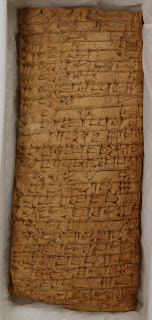Civilisations: Writing around the World
Writing is a significant part of everyday life. It is a form of communication we often don’t think about. But how important was writing in the past? This is the question I decided to focus on when creating a handling table for the BBC’s Civilisations Festival.
While selecting various types of writing that we have within the collection, I found that all over the world, different materials have been used as a writing surface. From clay tablets, to wax tablets, to metal, each material is chosen for a different purpose.
While selecting various types of writing that we have within the collection, I found that all over the world, different materials have been used as a writing surface. From clay tablets, to wax tablets, to metal, each material is chosen for a different purpose.
The clay tablets were written on using a wedge-shaped stylus, which is where Cuneiform gets its name as it means “wedge-shaped” in Latin. The tablets were reusable as long as they hadn’t been fired which means that all writing can, in theory, be temporary. This suggests the writing was intended to be a temporary and practical record rather than a permanent document of events. In many cases, it is thought that the tablets have been fired accidently, perhaps through an act of warfare where a building has been burnt down and fired the clay tablets inside.
 |
| The Cuneiform tablet within our collection dates to c.2027 BC |
The Roman Baths collection is the home of 130 curse tablets excavated from the Sacred Spring, each one bearing a message that has been scratched into a sheet of lead or pewter. Many of these are messages to the gods, asking for punishment to fall on the person who betrayed them. Others are just a list of names, are they asking for the gods to curse everyone on the list? Or, are they sending the gods a list of potential perpetrators and asking them to punish the person who did it?
Unlike the Cuneiform tablets, the curses were made to be a permanent and personal record of an event (even if the event was something small like having a glove stolen). These messages are personal and emotive; you can almost feel the anger in each scratch. These curses were deliberately placed in the Spring so that they could be found and read by the gods, and some remain unread even today.
 |
| Curse tablet with inscription "May he who has stolen VILBIA from me become as liquid as water..." |
It is clear that past civilisations used writing to document the most important things that were going on at the time. For the Sumerians, this began with accounting and evolved into administration, written on a material which allowed you to choose what was kept. The Roman curse tablets are written from a personal and emotional perspective, scratched onto a permanent surface as a physical manifestation of their feelings.
Whatever the focus of the text, writing is something that separates the human race from the animal kingdom. Many forms of writing have yet to be translated and we can only imagine the stories they tell!
Polly-Mae
Collections Intern

No comments:
Post a Comment